Strategic Human Resource Management Report: M&S and NHS Comparison
VerifiedAdded on 2023/01/06
|12
|3847
|23
Report
AI Summary
This report provides a comprehensive analysis of Strategic Human Resource Management (SHRM), focusing on the comparison between Marks & Spencer (M&S) in the private sector and the National Health Service (NHS) in the public sector. The introduction defines SHRM and highlights its significance in aligning HR policies with organizational objectives. Task 1 explores the relationship between business and HR strategies, examining vertical alignment, horizontal integration, and the impact of HR on competitive advantage. It also compares various SHRM models, including functional, organizational, process models, and relevant theories such as behavioral, contingency, and need-based theories. Furthermore, the report analyzes strategies for best fit, best practice, and resource-based views within the organizations, alongside performance management practices. Task 2 delves into employee relations, the roles of actors in the employment relationship, and offers recommendations for improvement. The report concludes by summarizing the key findings and emphasizing the importance of strategic HRM in achieving organizational goals. The analysis covers both private and public sector organizations providing a broad view of HRM strategies.
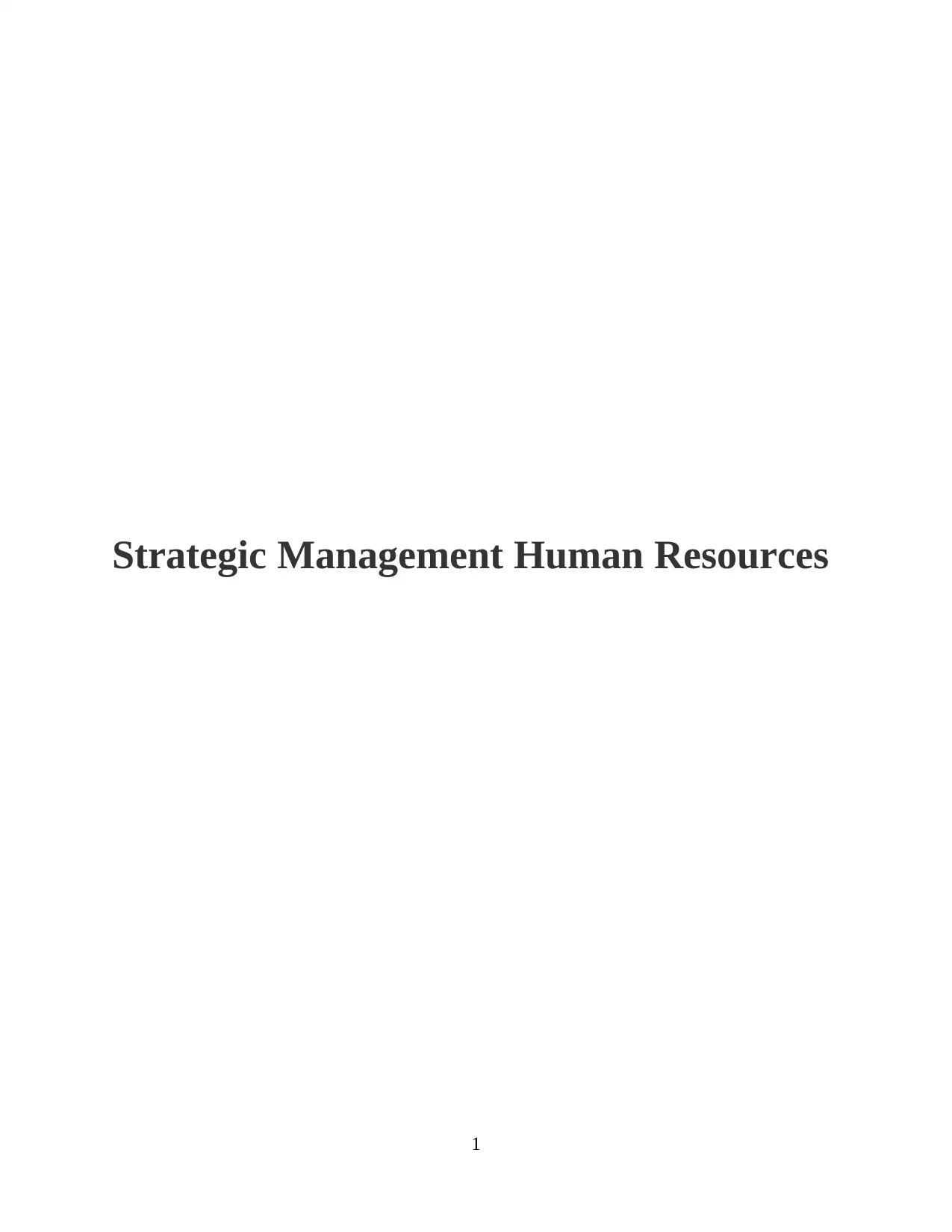
Strategic Management Human Resources
1
1
Paraphrase This Document
Need a fresh take? Get an instant paraphrase of this document with our AI Paraphraser
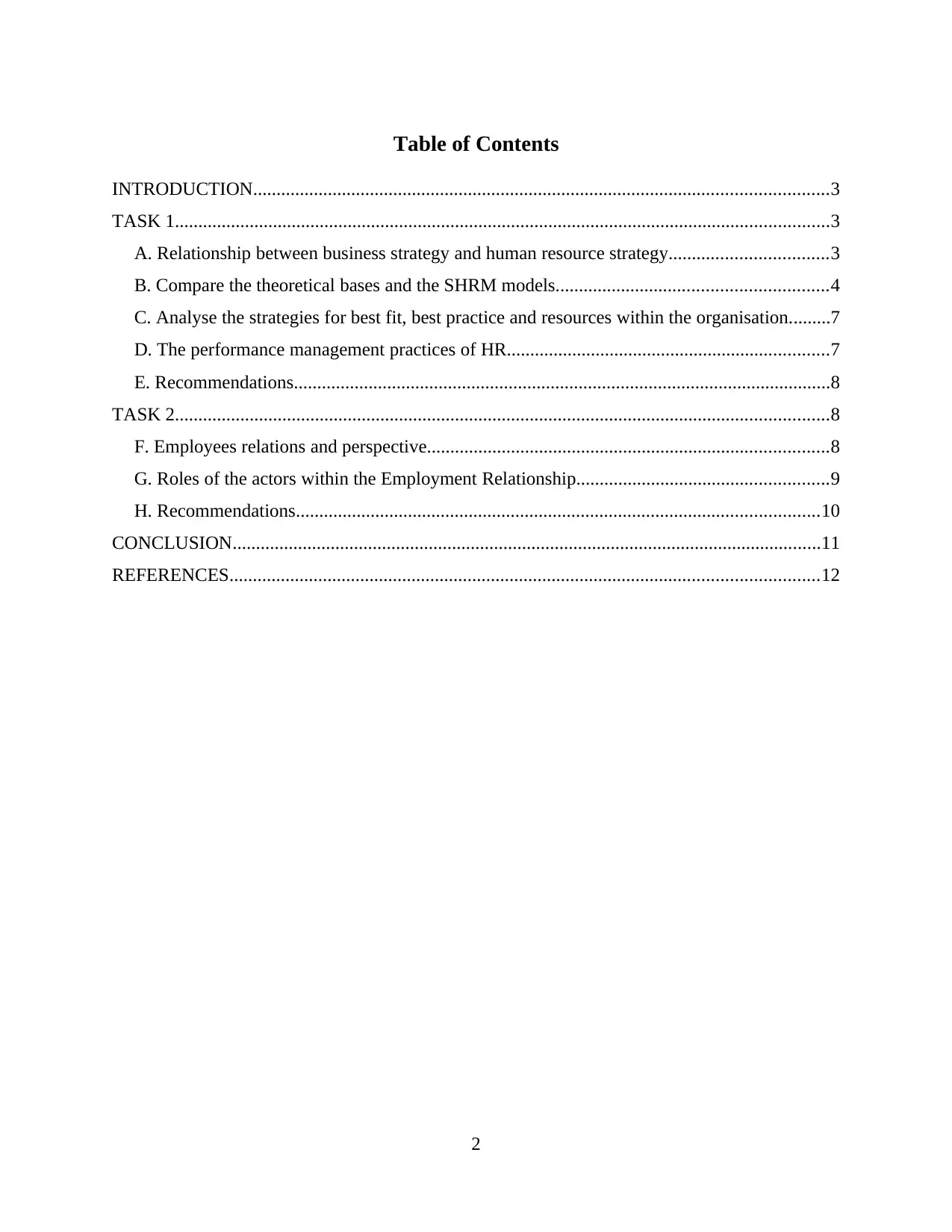
Table of Contents
INTRODUCTION...........................................................................................................................3
TASK 1............................................................................................................................................3
A. Relationship between business strategy and human resource strategy..................................3
B. Compare the theoretical bases and the SHRM models..........................................................4
C. Analyse the strategies for best fit, best practice and resources within the organisation.........7
D. The performance management practices of HR.....................................................................7
E. Recommendations...................................................................................................................8
TASK 2............................................................................................................................................8
F. Employees relations and perspective......................................................................................8
G. Roles of the actors within the Employment Relationship......................................................9
H. Recommendations................................................................................................................10
CONCLUSION..............................................................................................................................11
REFERENCES..............................................................................................................................12
2
INTRODUCTION...........................................................................................................................3
TASK 1............................................................................................................................................3
A. Relationship between business strategy and human resource strategy..................................3
B. Compare the theoretical bases and the SHRM models..........................................................4
C. Analyse the strategies for best fit, best practice and resources within the organisation.........7
D. The performance management practices of HR.....................................................................7
E. Recommendations...................................................................................................................8
TASK 2............................................................................................................................................8
F. Employees relations and perspective......................................................................................8
G. Roles of the actors within the Employment Relationship......................................................9
H. Recommendations................................................................................................................10
CONCLUSION..............................................................................................................................11
REFERENCES..............................................................................................................................12
2
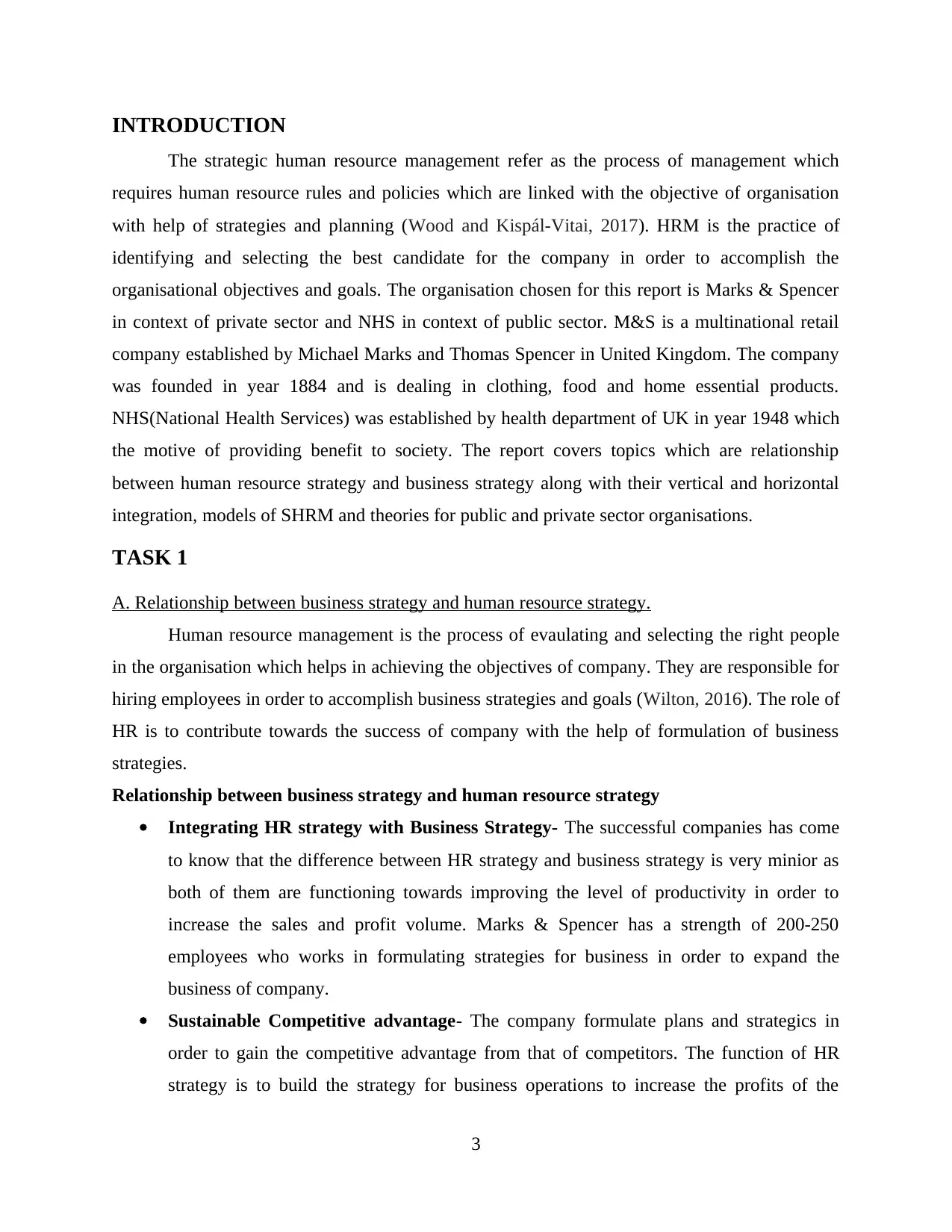
INTRODUCTION
The strategic human resource management refer as the process of management which
requires human resource rules and policies which are linked with the objective of organisation
with help of strategies and planning (Wood and Kispál-Vitai, 2017). HRM is the practice of
identifying and selecting the best candidate for the company in order to accomplish the
organisational objectives and goals. The organisation chosen for this report is Marks & Spencer
in context of private sector and NHS in context of public sector. M&S is a multinational retail
company established by Michael Marks and Thomas Spencer in United Kingdom. The company
was founded in year 1884 and is dealing in clothing, food and home essential products.
NHS(National Health Services) was established by health department of UK in year 1948 which
the motive of providing benefit to society. The report covers topics which are relationship
between human resource strategy and business strategy along with their vertical and horizontal
integration, models of SHRM and theories for public and private sector organisations.
TASK 1
A. Relationship between business strategy and human resource strategy.
Human resource management is the process of evaulating and selecting the right people
in the organisation which helps in achieving the objectives of company. They are responsible for
hiring employees in order to accomplish business strategies and goals (Wilton, 2016). The role of
HR is to contribute towards the success of company with the help of formulation of business
strategies.
Relationship between business strategy and human resource strategy
Integrating HR strategy with Business Strategy- The successful companies has come
to know that the difference between HR strategy and business strategy is very minior as
both of them are functioning towards improving the level of productivity in order to
increase the sales and profit volume. Marks & Spencer has a strength of 200-250
employees who works in formulating strategies for business in order to expand the
business of company.
Sustainable Competitive advantage- The company formulate plans and strategics in
order to gain the competitive advantage from that of competitors. The function of HR
strategy is to build the strategy for business operations to increase the profits of the
3
The strategic human resource management refer as the process of management which
requires human resource rules and policies which are linked with the objective of organisation
with help of strategies and planning (Wood and Kispál-Vitai, 2017). HRM is the practice of
identifying and selecting the best candidate for the company in order to accomplish the
organisational objectives and goals. The organisation chosen for this report is Marks & Spencer
in context of private sector and NHS in context of public sector. M&S is a multinational retail
company established by Michael Marks and Thomas Spencer in United Kingdom. The company
was founded in year 1884 and is dealing in clothing, food and home essential products.
NHS(National Health Services) was established by health department of UK in year 1948 which
the motive of providing benefit to society. The report covers topics which are relationship
between human resource strategy and business strategy along with their vertical and horizontal
integration, models of SHRM and theories for public and private sector organisations.
TASK 1
A. Relationship between business strategy and human resource strategy.
Human resource management is the process of evaulating and selecting the right people
in the organisation which helps in achieving the objectives of company. They are responsible for
hiring employees in order to accomplish business strategies and goals (Wilton, 2016). The role of
HR is to contribute towards the success of company with the help of formulation of business
strategies.
Relationship between business strategy and human resource strategy
Integrating HR strategy with Business Strategy- The successful companies has come
to know that the difference between HR strategy and business strategy is very minior as
both of them are functioning towards improving the level of productivity in order to
increase the sales and profit volume. Marks & Spencer has a strength of 200-250
employees who works in formulating strategies for business in order to expand the
business of company.
Sustainable Competitive advantage- The company formulate plans and strategics in
order to gain the competitive advantage from that of competitors. The function of HR
strategy is to build the strategy for business operations to increase the profits of the
3
⊘ This is a preview!⊘
Do you want full access?
Subscribe today to unlock all pages.

Trusted by 1+ million students worldwide
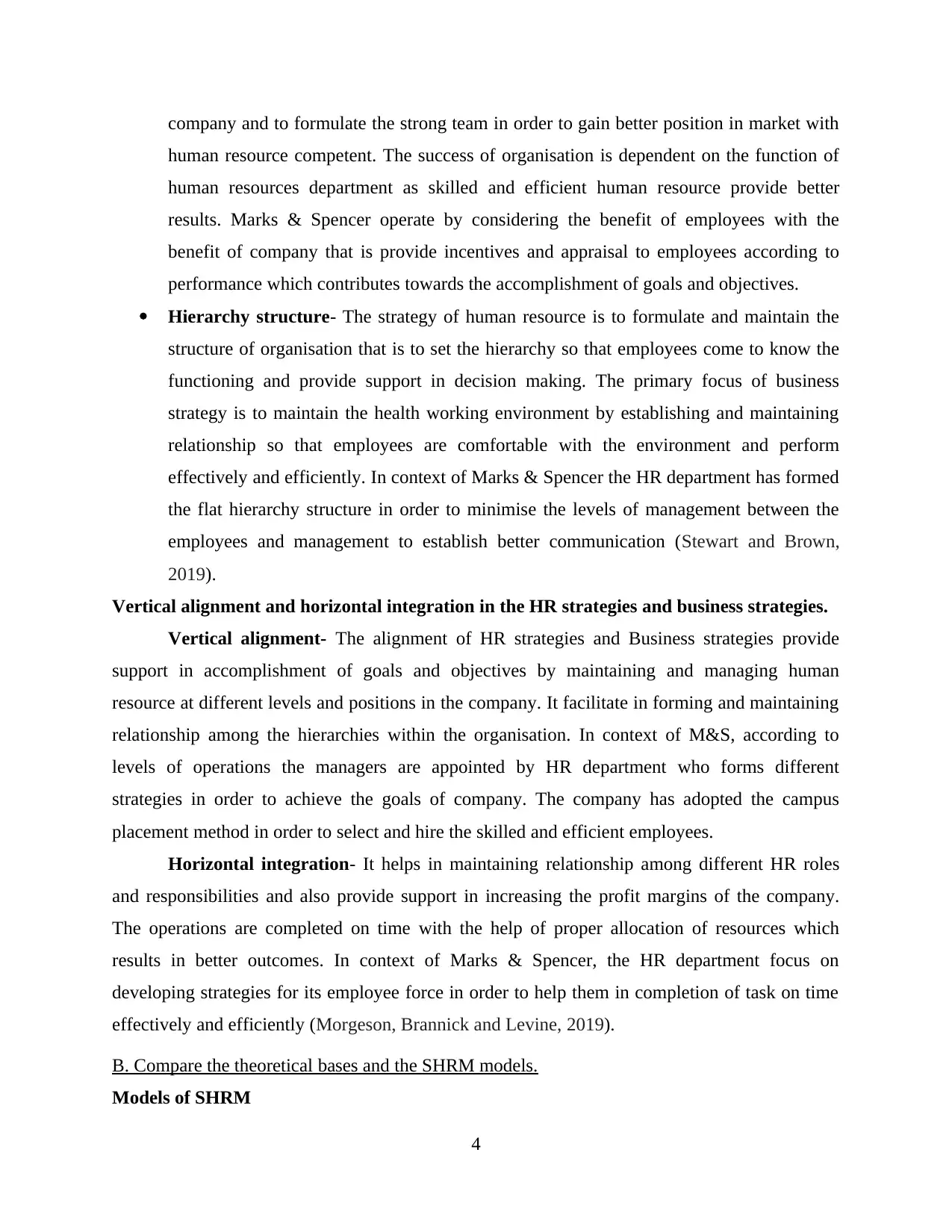
company and to formulate the strong team in order to gain better position in market with
human resource competent. The success of organisation is dependent on the function of
human resources department as skilled and efficient human resource provide better
results. Marks & Spencer operate by considering the benefit of employees with the
benefit of company that is provide incentives and appraisal to employees according to
performance which contributes towards the accomplishment of goals and objectives.
Hierarchy structure- The strategy of human resource is to formulate and maintain the
structure of organisation that is to set the hierarchy so that employees come to know the
functioning and provide support in decision making. The primary focus of business
strategy is to maintain the health working environment by establishing and maintaining
relationship so that employees are comfortable with the environment and perform
effectively and efficiently. In context of Marks & Spencer the HR department has formed
the flat hierarchy structure in order to minimise the levels of management between the
employees and management to establish better communication (Stewart and Brown,
2019).
Vertical alignment and horizontal integration in the HR strategies and business strategies.
Vertical alignment- The alignment of HR strategies and Business strategies provide
support in accomplishment of goals and objectives by maintaining and managing human
resource at different levels and positions in the company. It facilitate in forming and maintaining
relationship among the hierarchies within the organisation. In context of M&S, according to
levels of operations the managers are appointed by HR department who forms different
strategies in order to achieve the goals of company. The company has adopted the campus
placement method in order to select and hire the skilled and efficient employees.
Horizontal integration- It helps in maintaining relationship among different HR roles
and responsibilities and also provide support in increasing the profit margins of the company.
The operations are completed on time with the help of proper allocation of resources which
results in better outcomes. In context of Marks & Spencer, the HR department focus on
developing strategies for its employee force in order to help them in completion of task on time
effectively and efficiently (Morgeson, Brannick and Levine, 2019).
B. Compare the theoretical bases and the SHRM models.
Models of SHRM
4
human resource competent. The success of organisation is dependent on the function of
human resources department as skilled and efficient human resource provide better
results. Marks & Spencer operate by considering the benefit of employees with the
benefit of company that is provide incentives and appraisal to employees according to
performance which contributes towards the accomplishment of goals and objectives.
Hierarchy structure- The strategy of human resource is to formulate and maintain the
structure of organisation that is to set the hierarchy so that employees come to know the
functioning and provide support in decision making. The primary focus of business
strategy is to maintain the health working environment by establishing and maintaining
relationship so that employees are comfortable with the environment and perform
effectively and efficiently. In context of Marks & Spencer the HR department has formed
the flat hierarchy structure in order to minimise the levels of management between the
employees and management to establish better communication (Stewart and Brown,
2019).
Vertical alignment and horizontal integration in the HR strategies and business strategies.
Vertical alignment- The alignment of HR strategies and Business strategies provide
support in accomplishment of goals and objectives by maintaining and managing human
resource at different levels and positions in the company. It facilitate in forming and maintaining
relationship among the hierarchies within the organisation. In context of M&S, according to
levels of operations the managers are appointed by HR department who forms different
strategies in order to achieve the goals of company. The company has adopted the campus
placement method in order to select and hire the skilled and efficient employees.
Horizontal integration- It helps in maintaining relationship among different HR roles
and responsibilities and also provide support in increasing the profit margins of the company.
The operations are completed on time with the help of proper allocation of resources which
results in better outcomes. In context of Marks & Spencer, the HR department focus on
developing strategies for its employee force in order to help them in completion of task on time
effectively and efficiently (Morgeson, Brannick and Levine, 2019).
B. Compare the theoretical bases and the SHRM models.
Models of SHRM
4
Paraphrase This Document
Need a fresh take? Get an instant paraphrase of this document with our AI Paraphraser
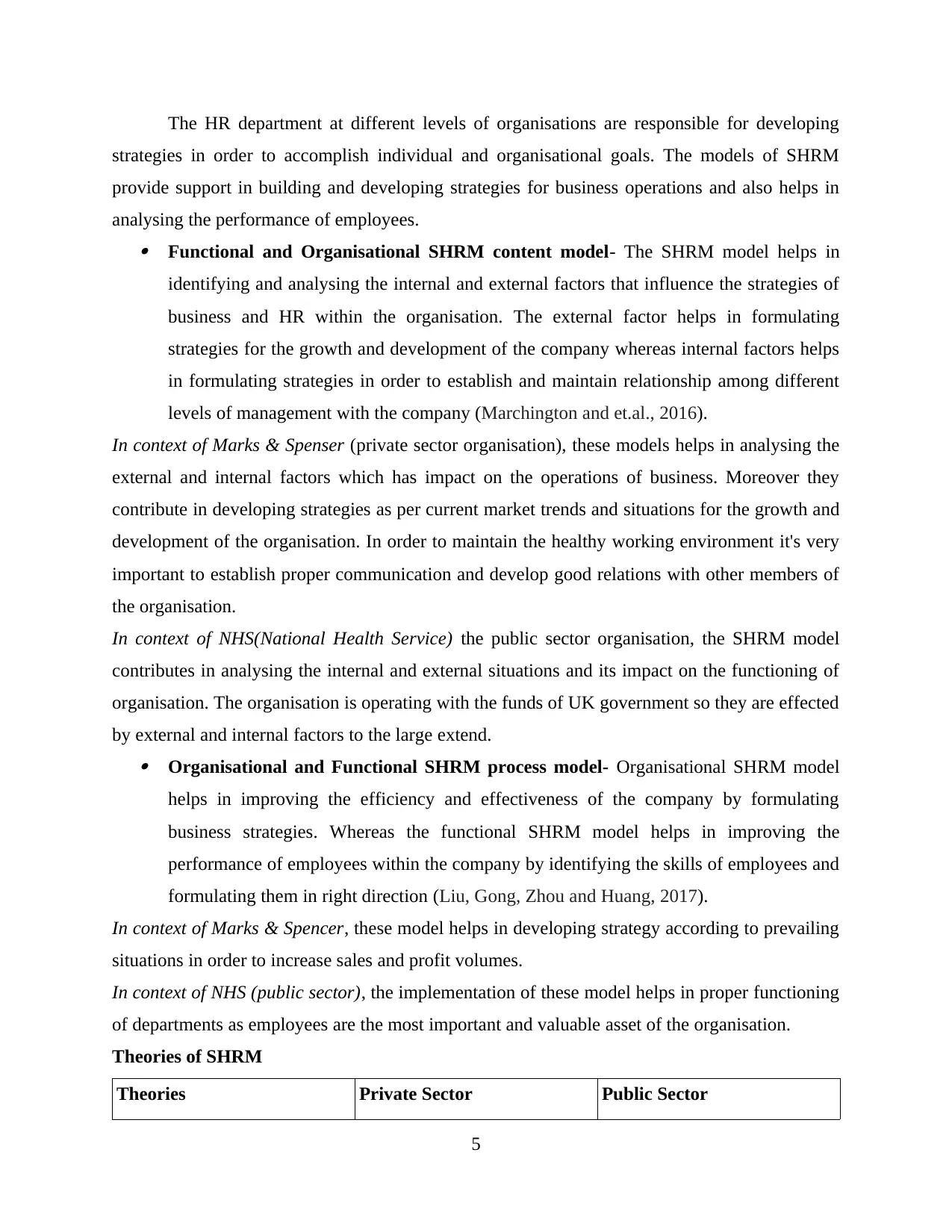
The HR department at different levels of organisations are responsible for developing
strategies in order to accomplish individual and organisational goals. The models of SHRM
provide support in building and developing strategies for business operations and also helps in
analysing the performance of employees. Functional and Organisational SHRM content model- The SHRM model helps in
identifying and analysing the internal and external factors that influence the strategies of
business and HR within the organisation. The external factor helps in formulating
strategies for the growth and development of the company whereas internal factors helps
in formulating strategies in order to establish and maintain relationship among different
levels of management with the company (Marchington and et.al., 2016).
In context of Marks & Spenser (private sector organisation), these models helps in analysing the
external and internal factors which has impact on the operations of business. Moreover they
contribute in developing strategies as per current market trends and situations for the growth and
development of the organisation. In order to maintain the healthy working environment it's very
important to establish proper communication and develop good relations with other members of
the organisation.
In context of NHS(National Health Service) the public sector organisation, the SHRM model
contributes in analysing the internal and external situations and its impact on the functioning of
organisation. The organisation is operating with the funds of UK government so they are effected
by external and internal factors to the large extend. Organisational and Functional SHRM process model- Organisational SHRM model
helps in improving the efficiency and effectiveness of the company by formulating
business strategies. Whereas the functional SHRM model helps in improving the
performance of employees within the company by identifying the skills of employees and
formulating them in right direction (Liu, Gong, Zhou and Huang, 2017).
In context of Marks & Spencer, these model helps in developing strategy according to prevailing
situations in order to increase sales and profit volumes.
In context of NHS (public sector), the implementation of these model helps in proper functioning
of departments as employees are the most important and valuable asset of the organisation.
Theories of SHRM
Theories Private Sector Public Sector
5
strategies in order to accomplish individual and organisational goals. The models of SHRM
provide support in building and developing strategies for business operations and also helps in
analysing the performance of employees. Functional and Organisational SHRM content model- The SHRM model helps in
identifying and analysing the internal and external factors that influence the strategies of
business and HR within the organisation. The external factor helps in formulating
strategies for the growth and development of the company whereas internal factors helps
in formulating strategies in order to establish and maintain relationship among different
levels of management with the company (Marchington and et.al., 2016).
In context of Marks & Spenser (private sector organisation), these models helps in analysing the
external and internal factors which has impact on the operations of business. Moreover they
contribute in developing strategies as per current market trends and situations for the growth and
development of the organisation. In order to maintain the healthy working environment it's very
important to establish proper communication and develop good relations with other members of
the organisation.
In context of NHS(National Health Service) the public sector organisation, the SHRM model
contributes in analysing the internal and external situations and its impact on the functioning of
organisation. The organisation is operating with the funds of UK government so they are effected
by external and internal factors to the large extend. Organisational and Functional SHRM process model- Organisational SHRM model
helps in improving the efficiency and effectiveness of the company by formulating
business strategies. Whereas the functional SHRM model helps in improving the
performance of employees within the company by identifying the skills of employees and
formulating them in right direction (Liu, Gong, Zhou and Huang, 2017).
In context of Marks & Spencer, these model helps in developing strategy according to prevailing
situations in order to increase sales and profit volumes.
In context of NHS (public sector), the implementation of these model helps in proper functioning
of departments as employees are the most important and valuable asset of the organisation.
Theories of SHRM
Theories Private Sector Public Sector
5
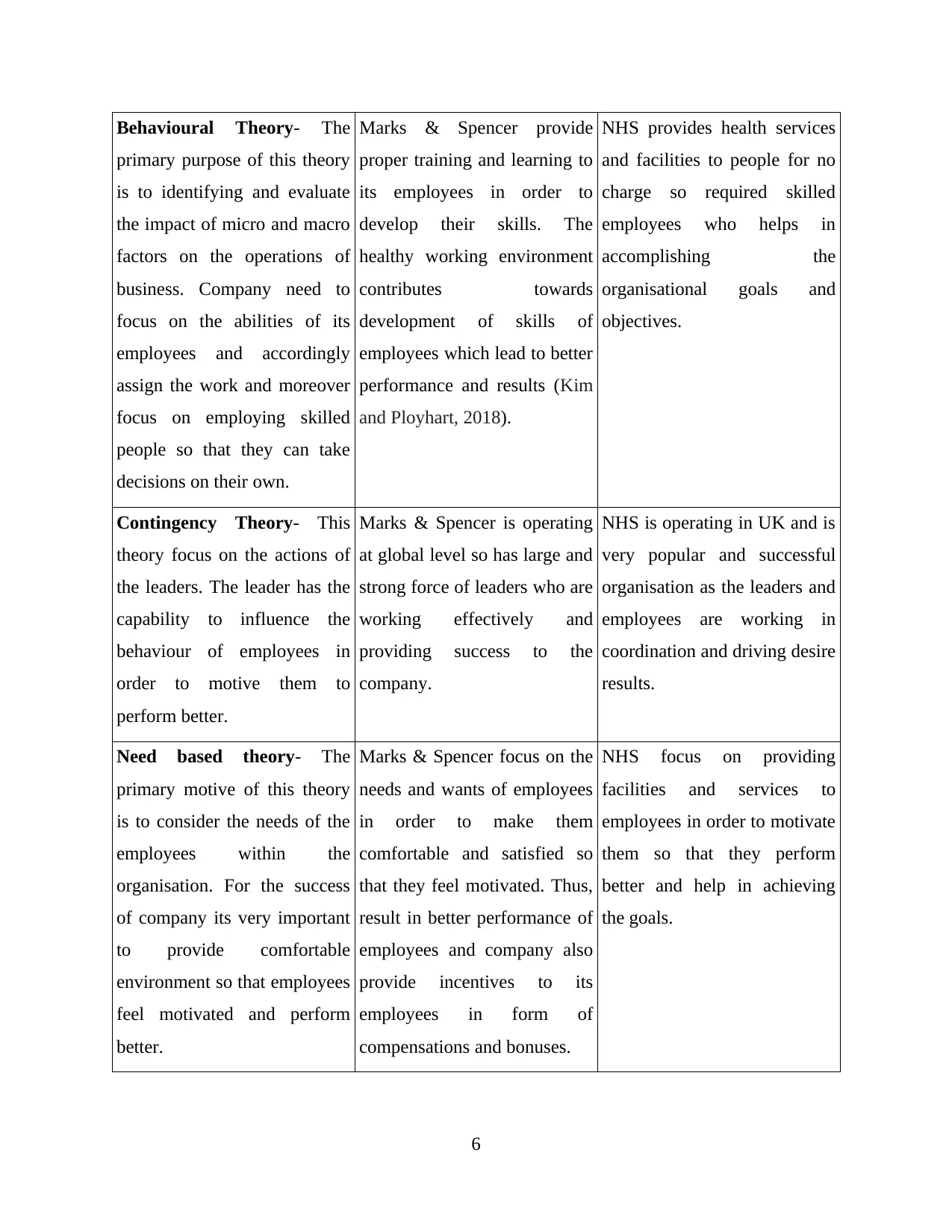
Behavioural Theory- The
primary purpose of this theory
is to identifying and evaluate
the impact of micro and macro
factors on the operations of
business. Company need to
focus on the abilities of its
employees and accordingly
assign the work and moreover
focus on employing skilled
people so that they can take
decisions on their own.
Marks & Spencer provide
proper training and learning to
its employees in order to
develop their skills. The
healthy working environment
contributes towards
development of skills of
employees which lead to better
performance and results (Kim
and Ployhart, 2018).
NHS provides health services
and facilities to people for no
charge so required skilled
employees who helps in
accomplishing the
organisational goals and
objectives.
Contingency Theory- This
theory focus on the actions of
the leaders. The leader has the
capability to influence the
behaviour of employees in
order to motive them to
perform better.
Marks & Spencer is operating
at global level so has large and
strong force of leaders who are
working effectively and
providing success to the
company.
NHS is operating in UK and is
very popular and successful
organisation as the leaders and
employees are working in
coordination and driving desire
results.
Need based theory- The
primary motive of this theory
is to consider the needs of the
employees within the
organisation. For the success
of company its very important
to provide comfortable
environment so that employees
feel motivated and perform
better.
Marks & Spencer focus on the
needs and wants of employees
in order to make them
comfortable and satisfied so
that they feel motivated. Thus,
result in better performance of
employees and company also
provide incentives to its
employees in form of
compensations and bonuses.
NHS focus on providing
facilities and services to
employees in order to motivate
them so that they perform
better and help in achieving
the goals.
6
primary purpose of this theory
is to identifying and evaluate
the impact of micro and macro
factors on the operations of
business. Company need to
focus on the abilities of its
employees and accordingly
assign the work and moreover
focus on employing skilled
people so that they can take
decisions on their own.
Marks & Spencer provide
proper training and learning to
its employees in order to
develop their skills. The
healthy working environment
contributes towards
development of skills of
employees which lead to better
performance and results (Kim
and Ployhart, 2018).
NHS provides health services
and facilities to people for no
charge so required skilled
employees who helps in
accomplishing the
organisational goals and
objectives.
Contingency Theory- This
theory focus on the actions of
the leaders. The leader has the
capability to influence the
behaviour of employees in
order to motive them to
perform better.
Marks & Spencer is operating
at global level so has large and
strong force of leaders who are
working effectively and
providing success to the
company.
NHS is operating in UK and is
very popular and successful
organisation as the leaders and
employees are working in
coordination and driving desire
results.
Need based theory- The
primary motive of this theory
is to consider the needs of the
employees within the
organisation. For the success
of company its very important
to provide comfortable
environment so that employees
feel motivated and perform
better.
Marks & Spencer focus on the
needs and wants of employees
in order to make them
comfortable and satisfied so
that they feel motivated. Thus,
result in better performance of
employees and company also
provide incentives to its
employees in form of
compensations and bonuses.
NHS focus on providing
facilities and services to
employees in order to motivate
them so that they perform
better and help in achieving
the goals.
6
⊘ This is a preview!⊘
Do you want full access?
Subscribe today to unlock all pages.

Trusted by 1+ million students worldwide
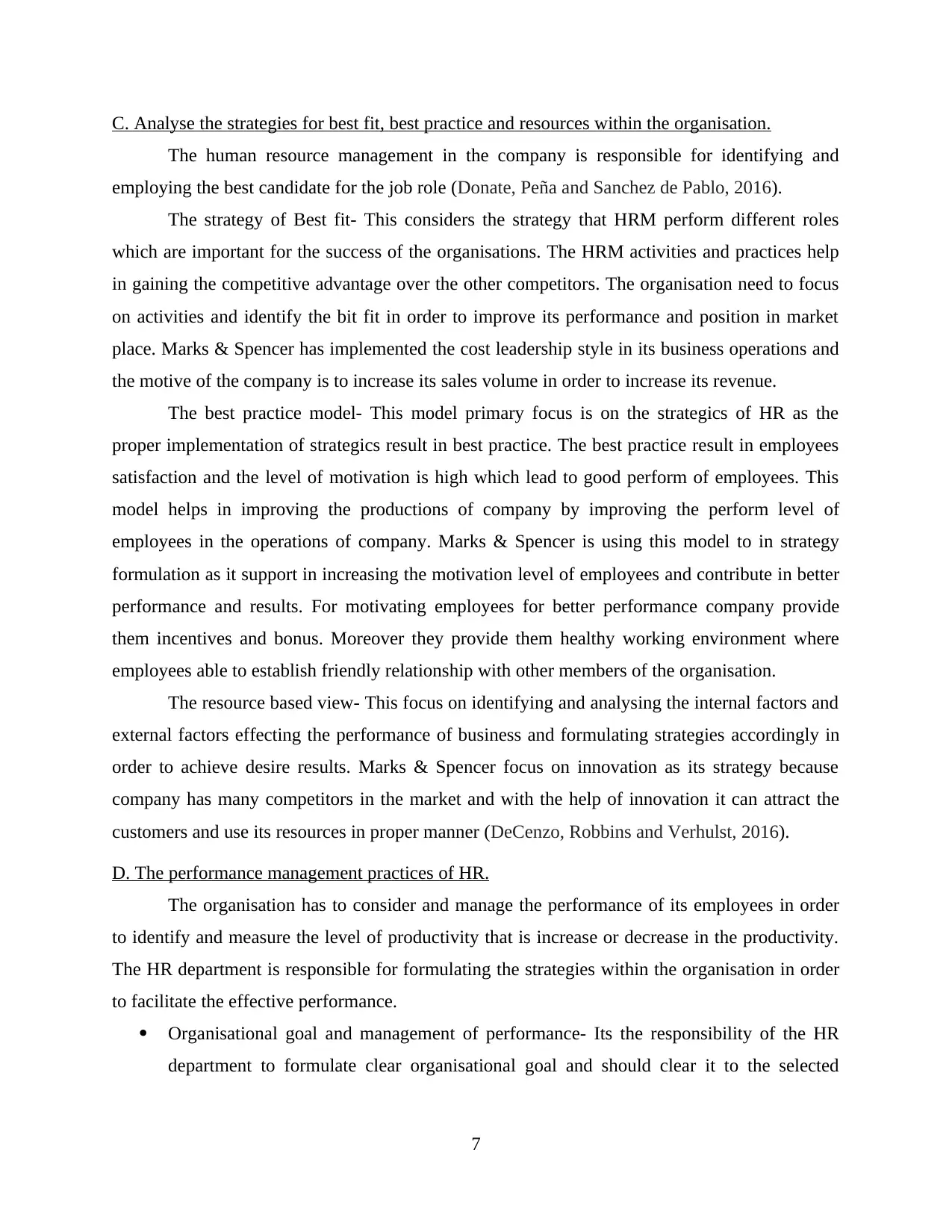
C. Analyse the strategies for best fit, best practice and resources within the organisation.
The human resource management in the company is responsible for identifying and
employing the best candidate for the job role (Donate, Peña and Sanchez de Pablo, 2016).
The strategy of Best fit- This considers the strategy that HRM perform different roles
which are important for the success of the organisations. The HRM activities and practices help
in gaining the competitive advantage over the other competitors. The organisation need to focus
on activities and identify the bit fit in order to improve its performance and position in market
place. Marks & Spencer has implemented the cost leadership style in its business operations and
the motive of the company is to increase its sales volume in order to increase its revenue.
The best practice model- This model primary focus is on the strategics of HR as the
proper implementation of strategics result in best practice. The best practice result in employees
satisfaction and the level of motivation is high which lead to good perform of employees. This
model helps in improving the productions of company by improving the perform level of
employees in the operations of company. Marks & Spencer is using this model to in strategy
formulation as it support in increasing the motivation level of employees and contribute in better
performance and results. For motivating employees for better performance company provide
them incentives and bonus. Moreover they provide them healthy working environment where
employees able to establish friendly relationship with other members of the organisation.
The resource based view- This focus on identifying and analysing the internal factors and
external factors effecting the performance of business and formulating strategies accordingly in
order to achieve desire results. Marks & Spencer focus on innovation as its strategy because
company has many competitors in the market and with the help of innovation it can attract the
customers and use its resources in proper manner (DeCenzo, Robbins and Verhulst, 2016).
D. The performance management practices of HR.
The organisation has to consider and manage the performance of its employees in order
to identify and measure the level of productivity that is increase or decrease in the productivity.
The HR department is responsible for formulating the strategies within the organisation in order
to facilitate the effective performance.
Organisational goal and management of performance- Its the responsibility of the HR
department to formulate clear organisational goal and should clear it to the selected
7
The human resource management in the company is responsible for identifying and
employing the best candidate for the job role (Donate, Peña and Sanchez de Pablo, 2016).
The strategy of Best fit- This considers the strategy that HRM perform different roles
which are important for the success of the organisations. The HRM activities and practices help
in gaining the competitive advantage over the other competitors. The organisation need to focus
on activities and identify the bit fit in order to improve its performance and position in market
place. Marks & Spencer has implemented the cost leadership style in its business operations and
the motive of the company is to increase its sales volume in order to increase its revenue.
The best practice model- This model primary focus is on the strategics of HR as the
proper implementation of strategics result in best practice. The best practice result in employees
satisfaction and the level of motivation is high which lead to good perform of employees. This
model helps in improving the productions of company by improving the perform level of
employees in the operations of company. Marks & Spencer is using this model to in strategy
formulation as it support in increasing the motivation level of employees and contribute in better
performance and results. For motivating employees for better performance company provide
them incentives and bonus. Moreover they provide them healthy working environment where
employees able to establish friendly relationship with other members of the organisation.
The resource based view- This focus on identifying and analysing the internal factors and
external factors effecting the performance of business and formulating strategies accordingly in
order to achieve desire results. Marks & Spencer focus on innovation as its strategy because
company has many competitors in the market and with the help of innovation it can attract the
customers and use its resources in proper manner (DeCenzo, Robbins and Verhulst, 2016).
D. The performance management practices of HR.
The organisation has to consider and manage the performance of its employees in order
to identify and measure the level of productivity that is increase or decrease in the productivity.
The HR department is responsible for formulating the strategies within the organisation in order
to facilitate the effective performance.
Organisational goal and management of performance- Its the responsibility of the HR
department to formulate clear organisational goal and should clear it to the selected
7
Paraphrase This Document
Need a fresh take? Get an instant paraphrase of this document with our AI Paraphraser
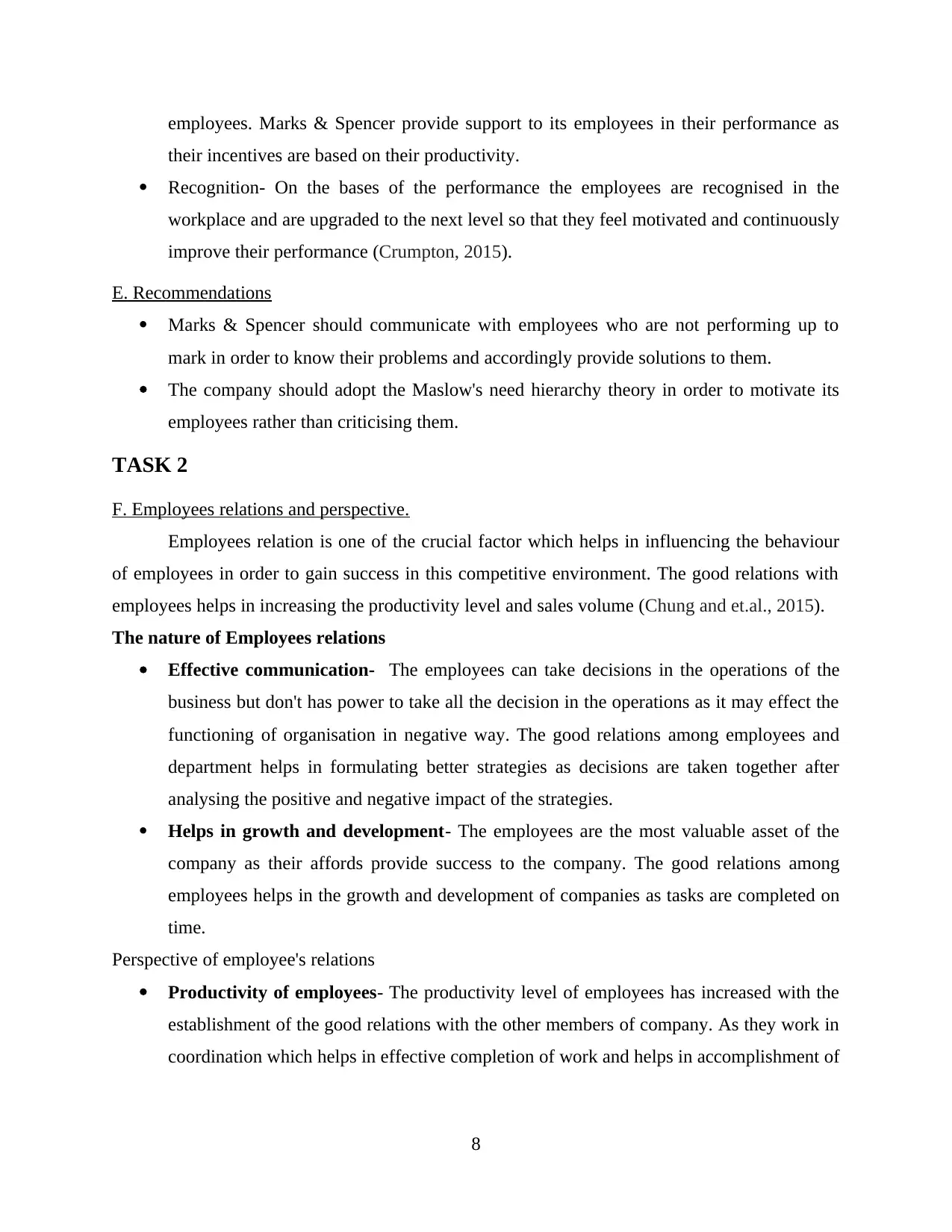
employees. Marks & Spencer provide support to its employees in their performance as
their incentives are based on their productivity.
Recognition- On the bases of the performance the employees are recognised in the
workplace and are upgraded to the next level so that they feel motivated and continuously
improve their performance (Crumpton, 2015).
E. Recommendations
Marks & Spencer should communicate with employees who are not performing up to
mark in order to know their problems and accordingly provide solutions to them.
The company should adopt the Maslow's need hierarchy theory in order to motivate its
employees rather than criticising them.
TASK 2
F. Employees relations and perspective.
Employees relation is one of the crucial factor which helps in influencing the behaviour
of employees in order to gain success in this competitive environment. The good relations with
employees helps in increasing the productivity level and sales volume (Chung and et.al., 2015).
The nature of Employees relations
Effective communication- The employees can take decisions in the operations of the
business but don't has power to take all the decision in the operations as it may effect the
functioning of organisation in negative way. The good relations among employees and
department helps in formulating better strategies as decisions are taken together after
analysing the positive and negative impact of the strategies.
Helps in growth and development- The employees are the most valuable asset of the
company as their affords provide success to the company. The good relations among
employees helps in the growth and development of companies as tasks are completed on
time.
Perspective of employee's relations
Productivity of employees- The productivity level of employees has increased with the
establishment of the good relations with the other members of company. As they work in
coordination which helps in effective completion of work and helps in accomplishment of
8
their incentives are based on their productivity.
Recognition- On the bases of the performance the employees are recognised in the
workplace and are upgraded to the next level so that they feel motivated and continuously
improve their performance (Crumpton, 2015).
E. Recommendations
Marks & Spencer should communicate with employees who are not performing up to
mark in order to know their problems and accordingly provide solutions to them.
The company should adopt the Maslow's need hierarchy theory in order to motivate its
employees rather than criticising them.
TASK 2
F. Employees relations and perspective.
Employees relation is one of the crucial factor which helps in influencing the behaviour
of employees in order to gain success in this competitive environment. The good relations with
employees helps in increasing the productivity level and sales volume (Chung and et.al., 2015).
The nature of Employees relations
Effective communication- The employees can take decisions in the operations of the
business but don't has power to take all the decision in the operations as it may effect the
functioning of organisation in negative way. The good relations among employees and
department helps in formulating better strategies as decisions are taken together after
analysing the positive and negative impact of the strategies.
Helps in growth and development- The employees are the most valuable asset of the
company as their affords provide success to the company. The good relations among
employees helps in the growth and development of companies as tasks are completed on
time.
Perspective of employee's relations
Productivity of employees- The productivity level of employees has increased with the
establishment of the good relations with the other members of company. As they work in
coordination which helps in effective completion of work and helps in accomplishment of
8
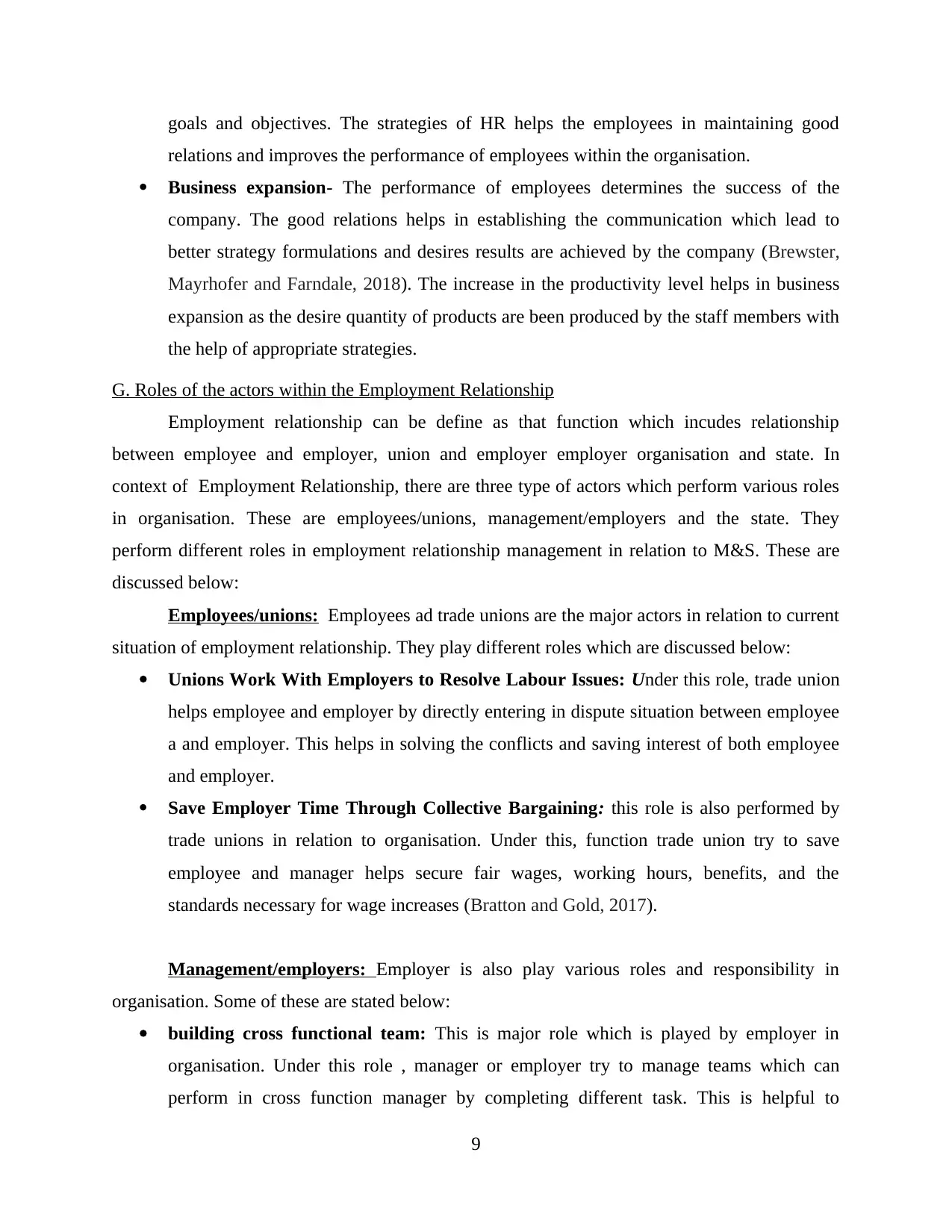
goals and objectives. The strategies of HR helps the employees in maintaining good
relations and improves the performance of employees within the organisation.
Business expansion- The performance of employees determines the success of the
company. The good relations helps in establishing the communication which lead to
better strategy formulations and desires results are achieved by the company (Brewster,
Mayrhofer and Farndale, 2018). The increase in the productivity level helps in business
expansion as the desire quantity of products are been produced by the staff members with
the help of appropriate strategies.
G. Roles of the actors within the Employment Relationship
Employment relationship can be define as that function which incudes relationship
between employee and employer, union and employer employer organisation and state. In
context of Employment Relationship, there are three type of actors which perform various roles
in organisation. These are employees/unions, management/employers and the state. They
perform different roles in employment relationship management in relation to M&S. These are
discussed below:
Employees/unions: Employees ad trade unions are the major actors in relation to current
situation of employment relationship. They play different roles which are discussed below:
Unions Work With Employers to Resolve Labour Issues: Under this role, trade union
helps employee and employer by directly entering in dispute situation between employee
a and employer. This helps in solving the conflicts and saving interest of both employee
and employer.
Save Employer Time Through Collective Bargaining: this role is also performed by
trade unions in relation to organisation. Under this, function trade union try to save
employee and manager helps secure fair wages, working hours, benefits, and the
standards necessary for wage increases (Bratton and Gold, 2017).
Management/employers: Employer is also play various roles and responsibility in
organisation. Some of these are stated below:
building cross functional team: This is major role which is played by employer in
organisation. Under this role , manager or employer try to manage teams which can
perform in cross function manager by completing different task. This is helpful to
9
relations and improves the performance of employees within the organisation.
Business expansion- The performance of employees determines the success of the
company. The good relations helps in establishing the communication which lead to
better strategy formulations and desires results are achieved by the company (Brewster,
Mayrhofer and Farndale, 2018). The increase in the productivity level helps in business
expansion as the desire quantity of products are been produced by the staff members with
the help of appropriate strategies.
G. Roles of the actors within the Employment Relationship
Employment relationship can be define as that function which incudes relationship
between employee and employer, union and employer employer organisation and state. In
context of Employment Relationship, there are three type of actors which perform various roles
in organisation. These are employees/unions, management/employers and the state. They
perform different roles in employment relationship management in relation to M&S. These are
discussed below:
Employees/unions: Employees ad trade unions are the major actors in relation to current
situation of employment relationship. They play different roles which are discussed below:
Unions Work With Employers to Resolve Labour Issues: Under this role, trade union
helps employee and employer by directly entering in dispute situation between employee
a and employer. This helps in solving the conflicts and saving interest of both employee
and employer.
Save Employer Time Through Collective Bargaining: this role is also performed by
trade unions in relation to organisation. Under this, function trade union try to save
employee and manager helps secure fair wages, working hours, benefits, and the
standards necessary for wage increases (Bratton and Gold, 2017).
Management/employers: Employer is also play various roles and responsibility in
organisation. Some of these are stated below:
building cross functional team: This is major role which is played by employer in
organisation. Under this role , manager or employer try to manage teams which can
perform in cross function manager by completing different task. This is helpful to
9
⊘ This is a preview!⊘
Do you want full access?
Subscribe today to unlock all pages.

Trusted by 1+ million students worldwide
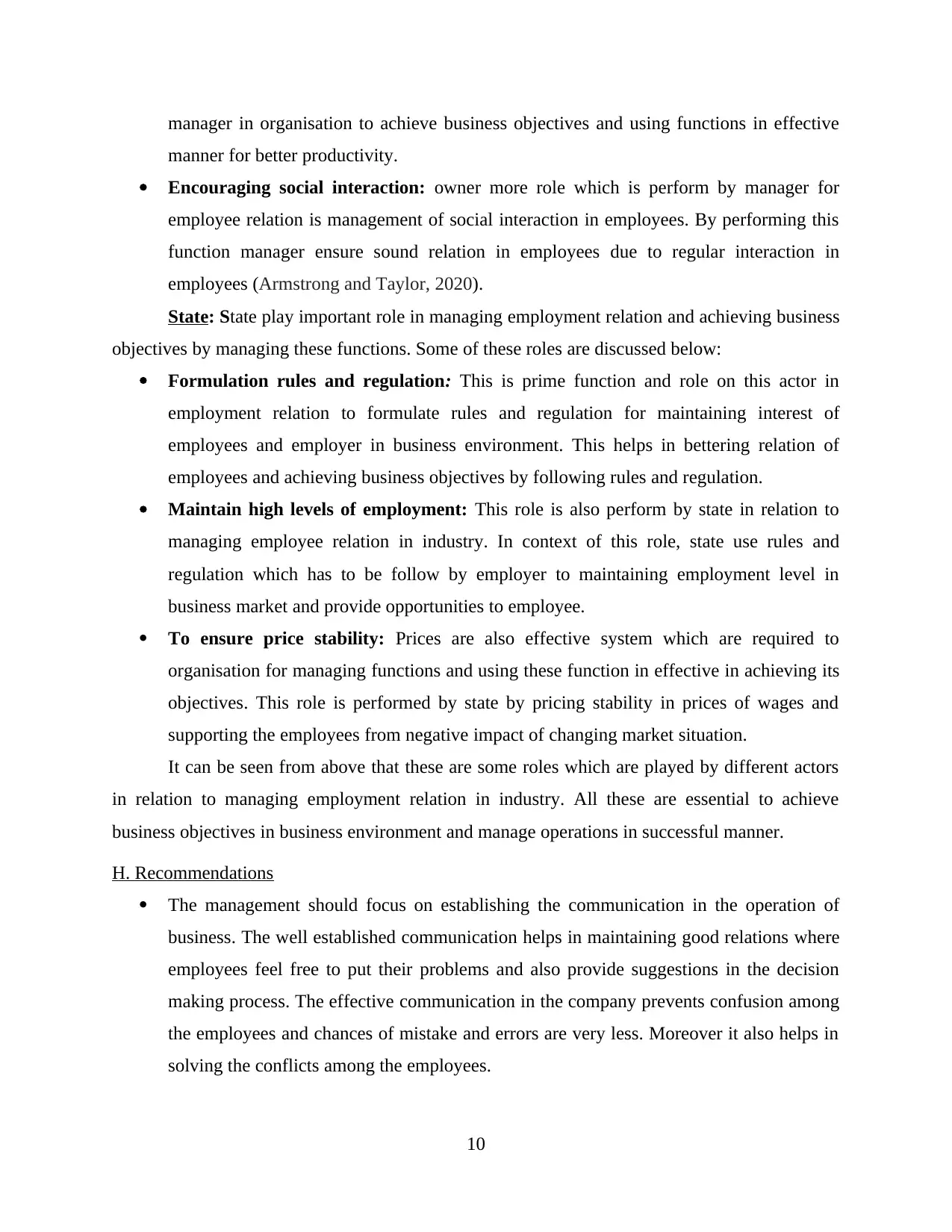
manager in organisation to achieve business objectives and using functions in effective
manner for better productivity.
Encouraging social interaction: owner more role which is perform by manager for
employee relation is management of social interaction in employees. By performing this
function manager ensure sound relation in employees due to regular interaction in
employees (Armstrong and Taylor, 2020).
State: State play important role in managing employment relation and achieving business
objectives by managing these functions. Some of these roles are discussed below:
Formulation rules and regulation: This is prime function and role on this actor in
employment relation to formulate rules and regulation for maintaining interest of
employees and employer in business environment. This helps in bettering relation of
employees and achieving business objectives by following rules and regulation.
Maintain high levels of employment: This role is also perform by state in relation to
managing employee relation in industry. In context of this role, state use rules and
regulation which has to be follow by employer to maintaining employment level in
business market and provide opportunities to employee.
To ensure price stability: Prices are also effective system which are required to
organisation for managing functions and using these function in effective in achieving its
objectives. This role is performed by state by pricing stability in prices of wages and
supporting the employees from negative impact of changing market situation.
It can be seen from above that these are some roles which are played by different actors
in relation to managing employment relation in industry. All these are essential to achieve
business objectives in business environment and manage operations in successful manner.
H. Recommendations
The management should focus on establishing the communication in the operation of
business. The well established communication helps in maintaining good relations where
employees feel free to put their problems and also provide suggestions in the decision
making process. The effective communication in the company prevents confusion among
the employees and chances of mistake and errors are very less. Moreover it also helps in
solving the conflicts among the employees.
10
manner for better productivity.
Encouraging social interaction: owner more role which is perform by manager for
employee relation is management of social interaction in employees. By performing this
function manager ensure sound relation in employees due to regular interaction in
employees (Armstrong and Taylor, 2020).
State: State play important role in managing employment relation and achieving business
objectives by managing these functions. Some of these roles are discussed below:
Formulation rules and regulation: This is prime function and role on this actor in
employment relation to formulate rules and regulation for maintaining interest of
employees and employer in business environment. This helps in bettering relation of
employees and achieving business objectives by following rules and regulation.
Maintain high levels of employment: This role is also perform by state in relation to
managing employee relation in industry. In context of this role, state use rules and
regulation which has to be follow by employer to maintaining employment level in
business market and provide opportunities to employee.
To ensure price stability: Prices are also effective system which are required to
organisation for managing functions and using these function in effective in achieving its
objectives. This role is performed by state by pricing stability in prices of wages and
supporting the employees from negative impact of changing market situation.
It can be seen from above that these are some roles which are played by different actors
in relation to managing employment relation in industry. All these are essential to achieve
business objectives in business environment and manage operations in successful manner.
H. Recommendations
The management should focus on establishing the communication in the operation of
business. The well established communication helps in maintaining good relations where
employees feel free to put their problems and also provide suggestions in the decision
making process. The effective communication in the company prevents confusion among
the employees and chances of mistake and errors are very less. Moreover it also helps in
solving the conflicts among the employees.
10
Paraphrase This Document
Need a fresh take? Get an instant paraphrase of this document with our AI Paraphraser
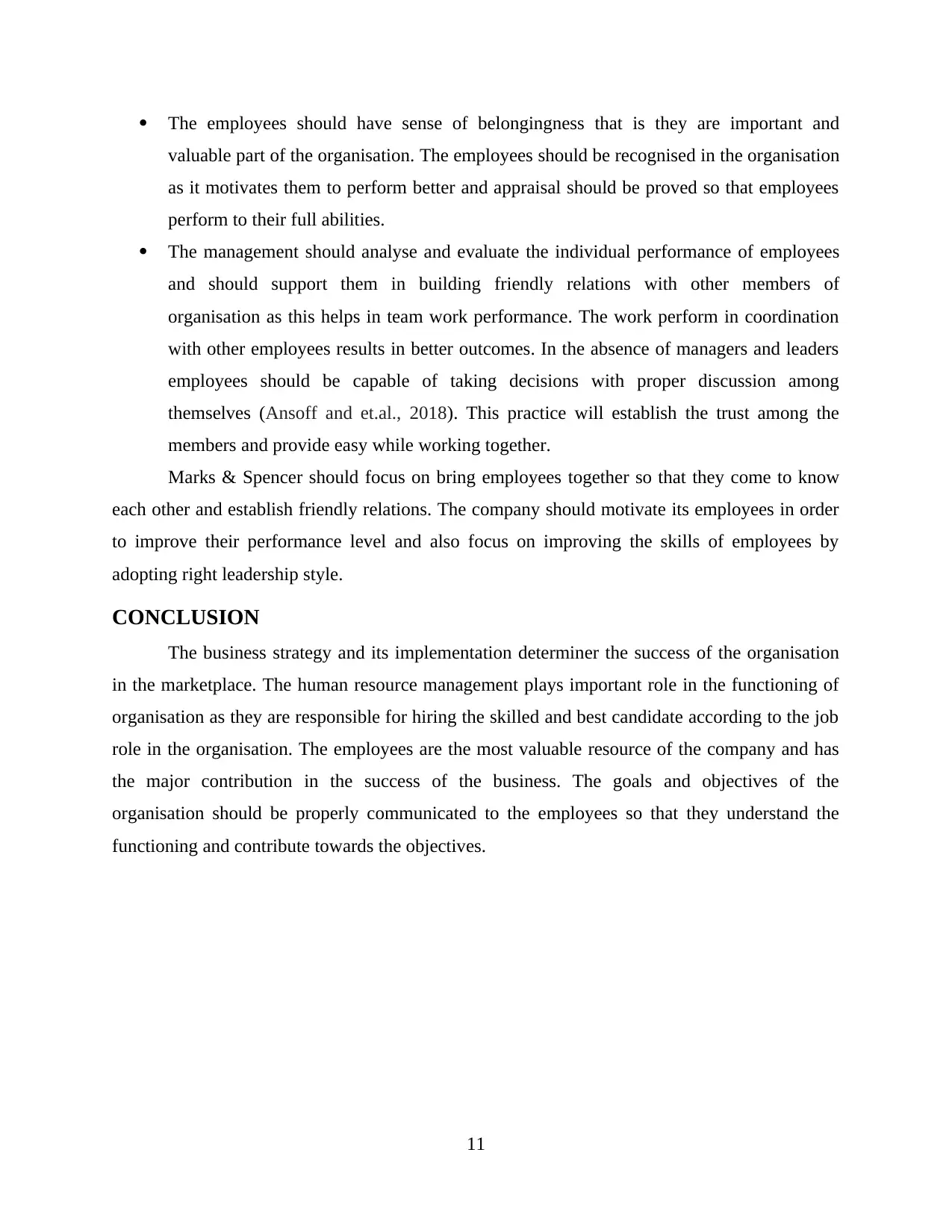
The employees should have sense of belongingness that is they are important and
valuable part of the organisation. The employees should be recognised in the organisation
as it motivates them to perform better and appraisal should be proved so that employees
perform to their full abilities.
The management should analyse and evaluate the individual performance of employees
and should support them in building friendly relations with other members of
organisation as this helps in team work performance. The work perform in coordination
with other employees results in better outcomes. In the absence of managers and leaders
employees should be capable of taking decisions with proper discussion among
themselves (Ansoff and et.al., 2018). This practice will establish the trust among the
members and provide easy while working together.
Marks & Spencer should focus on bring employees together so that they come to know
each other and establish friendly relations. The company should motivate its employees in order
to improve their performance level and also focus on improving the skills of employees by
adopting right leadership style.
CONCLUSION
The business strategy and its implementation determiner the success of the organisation
in the marketplace. The human resource management plays important role in the functioning of
organisation as they are responsible for hiring the skilled and best candidate according to the job
role in the organisation. The employees are the most valuable resource of the company and has
the major contribution in the success of the business. The goals and objectives of the
organisation should be properly communicated to the employees so that they understand the
functioning and contribute towards the objectives.
11
valuable part of the organisation. The employees should be recognised in the organisation
as it motivates them to perform better and appraisal should be proved so that employees
perform to their full abilities.
The management should analyse and evaluate the individual performance of employees
and should support them in building friendly relations with other members of
organisation as this helps in team work performance. The work perform in coordination
with other employees results in better outcomes. In the absence of managers and leaders
employees should be capable of taking decisions with proper discussion among
themselves (Ansoff and et.al., 2018). This practice will establish the trust among the
members and provide easy while working together.
Marks & Spencer should focus on bring employees together so that they come to know
each other and establish friendly relations. The company should motivate its employees in order
to improve their performance level and also focus on improving the skills of employees by
adopting right leadership style.
CONCLUSION
The business strategy and its implementation determiner the success of the organisation
in the marketplace. The human resource management plays important role in the functioning of
organisation as they are responsible for hiring the skilled and best candidate according to the job
role in the organisation. The employees are the most valuable resource of the company and has
the major contribution in the success of the business. The goals and objectives of the
organisation should be properly communicated to the employees so that they understand the
functioning and contribute towards the objectives.
11
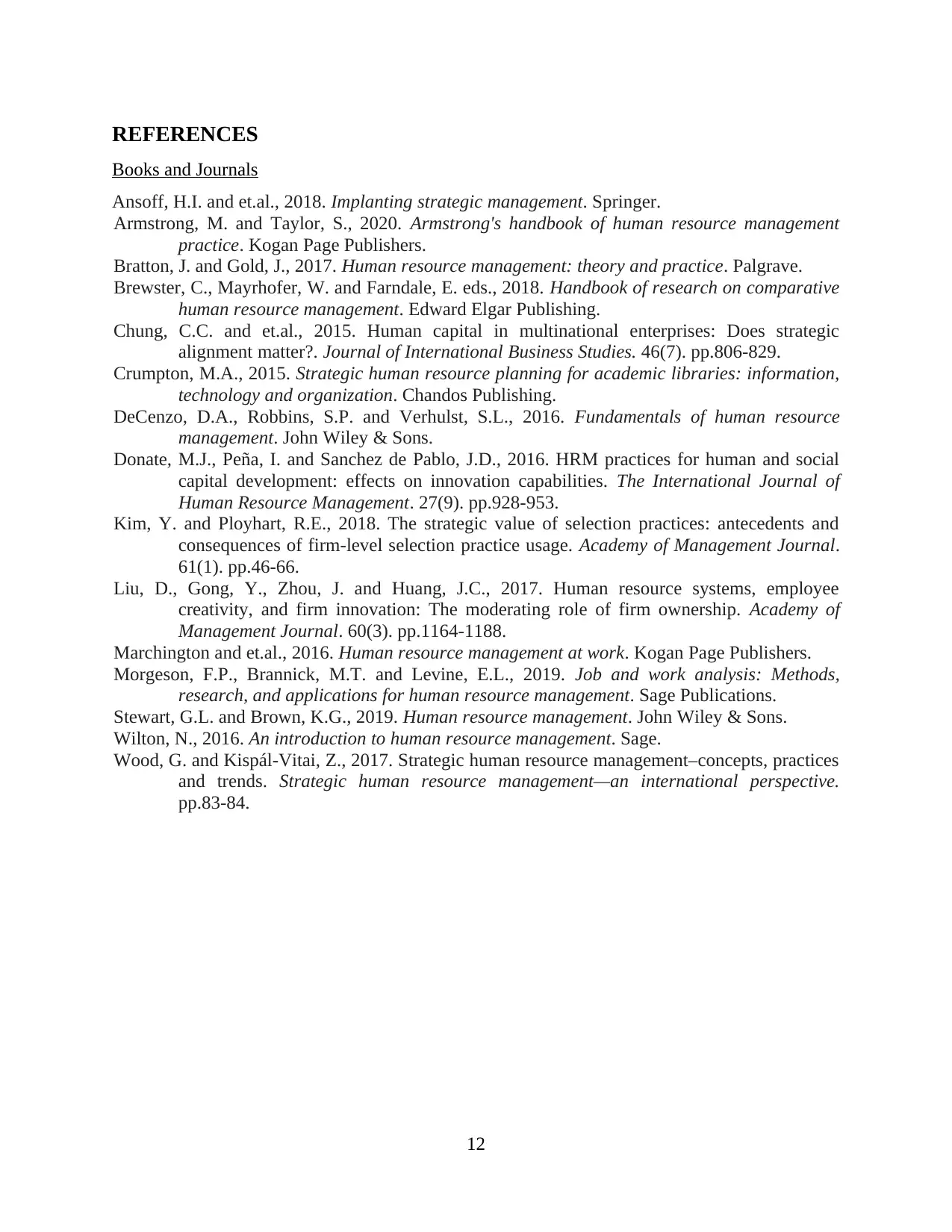
REFERENCES
Books and Journals
Ansoff, H.I. and et.al., 2018. Implanting strategic management. Springer.
Armstrong, M. and Taylor, S., 2020. Armstrong's handbook of human resource management
practice. Kogan Page Publishers.
Bratton, J. and Gold, J., 2017. Human resource management: theory and practice. Palgrave.
Brewster, C., Mayrhofer, W. and Farndale, E. eds., 2018. Handbook of research on comparative
human resource management. Edward Elgar Publishing.
Chung, C.C. and et.al., 2015. Human capital in multinational enterprises: Does strategic
alignment matter?. Journal of International Business Studies. 46(7). pp.806-829.
Crumpton, M.A., 2015. Strategic human resource planning for academic libraries: information,
technology and organization. Chandos Publishing.
DeCenzo, D.A., Robbins, S.P. and Verhulst, S.L., 2016. Fundamentals of human resource
management. John Wiley & Sons.
Donate, M.J., Peña, I. and Sanchez de Pablo, J.D., 2016. HRM practices for human and social
capital development: effects on innovation capabilities. The International Journal of
Human Resource Management. 27(9). pp.928-953.
Kim, Y. and Ployhart, R.E., 2018. The strategic value of selection practices: antecedents and
consequences of firm-level selection practice usage. Academy of Management Journal.
61(1). pp.46-66.
Liu, D., Gong, Y., Zhou, J. and Huang, J.C., 2017. Human resource systems, employee
creativity, and firm innovation: The moderating role of firm ownership. Academy of
Management Journal. 60(3). pp.1164-1188.
Marchington and et.al., 2016. Human resource management at work. Kogan Page Publishers.
Morgeson, F.P., Brannick, M.T. and Levine, E.L., 2019. Job and work analysis: Methods,
research, and applications for human resource management. Sage Publications.
Stewart, G.L. and Brown, K.G., 2019. Human resource management. John Wiley & Sons.
Wilton, N., 2016. An introduction to human resource management. Sage.
Wood, G. and Kispál-Vitai, Z., 2017. Strategic human resource management–concepts, practices
and trends. Strategic human resource management—an international perspective.
pp.83-84.
12
Books and Journals
Ansoff, H.I. and et.al., 2018. Implanting strategic management. Springer.
Armstrong, M. and Taylor, S., 2020. Armstrong's handbook of human resource management
practice. Kogan Page Publishers.
Bratton, J. and Gold, J., 2017. Human resource management: theory and practice. Palgrave.
Brewster, C., Mayrhofer, W. and Farndale, E. eds., 2018. Handbook of research on comparative
human resource management. Edward Elgar Publishing.
Chung, C.C. and et.al., 2015. Human capital in multinational enterprises: Does strategic
alignment matter?. Journal of International Business Studies. 46(7). pp.806-829.
Crumpton, M.A., 2015. Strategic human resource planning for academic libraries: information,
technology and organization. Chandos Publishing.
DeCenzo, D.A., Robbins, S.P. and Verhulst, S.L., 2016. Fundamentals of human resource
management. John Wiley & Sons.
Donate, M.J., Peña, I. and Sanchez de Pablo, J.D., 2016. HRM practices for human and social
capital development: effects on innovation capabilities. The International Journal of
Human Resource Management. 27(9). pp.928-953.
Kim, Y. and Ployhart, R.E., 2018. The strategic value of selection practices: antecedents and
consequences of firm-level selection practice usage. Academy of Management Journal.
61(1). pp.46-66.
Liu, D., Gong, Y., Zhou, J. and Huang, J.C., 2017. Human resource systems, employee
creativity, and firm innovation: The moderating role of firm ownership. Academy of
Management Journal. 60(3). pp.1164-1188.
Marchington and et.al., 2016. Human resource management at work. Kogan Page Publishers.
Morgeson, F.P., Brannick, M.T. and Levine, E.L., 2019. Job and work analysis: Methods,
research, and applications for human resource management. Sage Publications.
Stewart, G.L. and Brown, K.G., 2019. Human resource management. John Wiley & Sons.
Wilton, N., 2016. An introduction to human resource management. Sage.
Wood, G. and Kispál-Vitai, Z., 2017. Strategic human resource management–concepts, practices
and trends. Strategic human resource management—an international perspective.
pp.83-84.
12
⊘ This is a preview!⊘
Do you want full access?
Subscribe today to unlock all pages.

Trusted by 1+ million students worldwide
1 out of 12
Related Documents
Your All-in-One AI-Powered Toolkit for Academic Success.
+13062052269
info@desklib.com
Available 24*7 on WhatsApp / Email
![[object Object]](/_next/static/media/star-bottom.7253800d.svg)
Unlock your academic potential
Copyright © 2020–2025 A2Z Services. All Rights Reserved. Developed and managed by ZUCOL.




